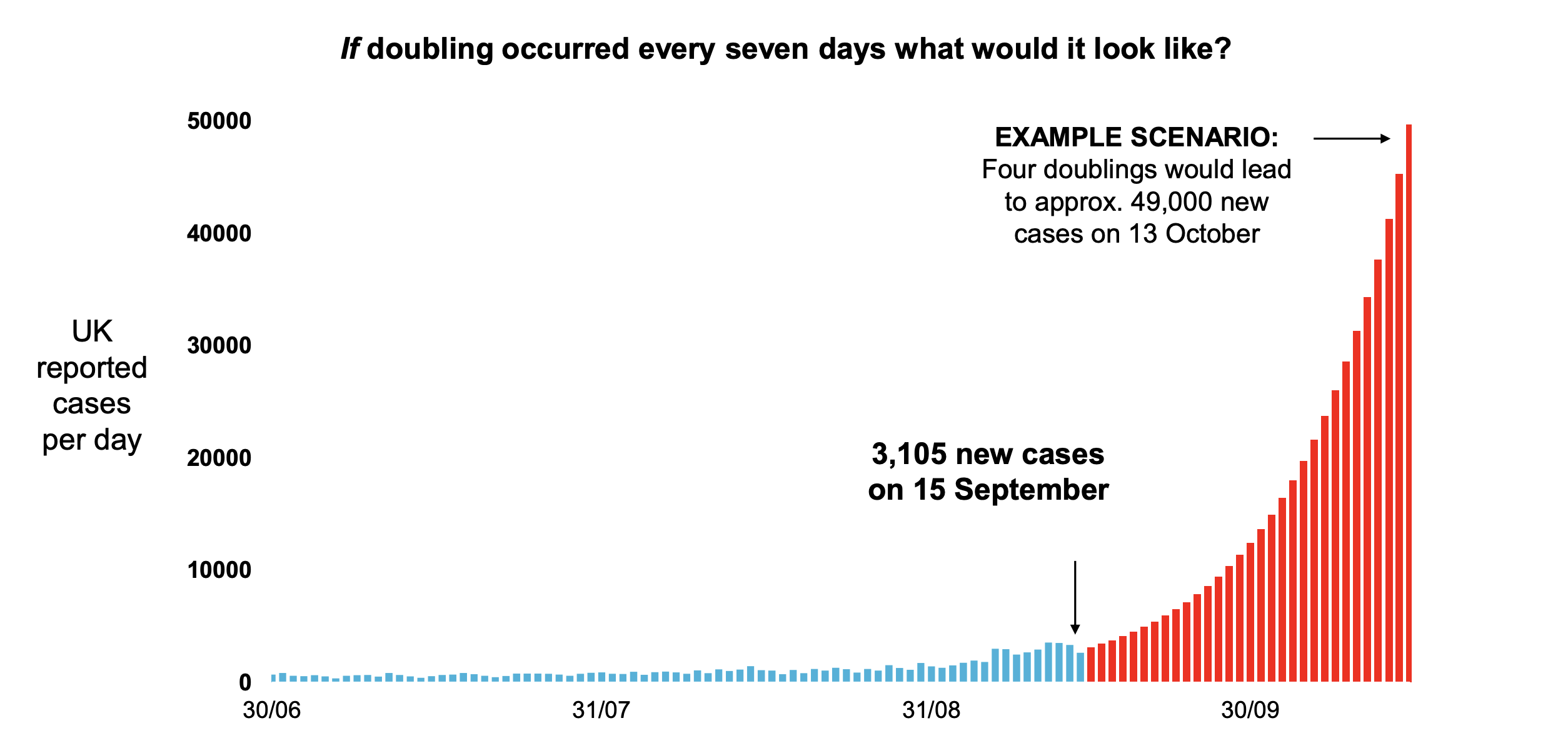Over the past 6 months, statistics have been misused so often by those who should know better that I find it almost impossible to be shocked anymore. Credit to England’s Chief Medical Officer (CMO) and the UK’s Chief Scientific Officer (CSO) for doing so with ease in their joint briefing yesterday.
The presentation started with Professor Chris Whitty and Sir Patrick Vallance showing that reported Coronavirus cases in France & Spain have risen recently to a daily average of 13 and 22 cases per 100 thousand people respectively. The suggestion was that the UK might be on a similar trajectory to these two countries.
So far so reasonable, but then came a slide purporting to show that cases in the UK could grow from 3,105 cases reported on the 15th September to 49,000 cases per day by the 13th October. The CMO and CSO are careful to say this is what might happen “if” UK cases were to double every 7 days.

Having just been talking about France & Spain, a casual observer might have thought they were showing what would happen if cases in the UK increased at a similar rate.
Actually, reported cases in France and Spain have been doubling in something closer to every 3 weeks rather than every 7-days. Had Whitty and Vallance used such a 3-week doubling time as a basis for their scenario, it would have taken them to under 10,000 cases per day by mid-October, not even close to the 49,000 that appeared on the slide.
To add to the confusion, the CMO and CSO switched their units of measurement. For Spain and France, they referred to average daily cases per 100 thousand people whereas for the UK they changed to using the number of cases per day. It is easy to see why: 50,000 cases per day in the UK works out to a rate of about 75 per 100,000 people.
Do the CMO and CSO seriously believe that the most likely scenario is one in which the UK will experience more than five times the current daily rate in France in just three weeks’ time? Had they reported the rate per population, it would straight away have alerted journalists and politicians that something odd was going on.
There are further questions about the way data at the briefing was presented. The Centre for Evidence Based Medicine at Oxford has demonstrated that, although reported cases are continuing to rise in Spain, the data by symptom date suggests actual infections started levelling off in late August. So why did the CMO and CSO choose to show us Spanish cases by date of reporting?
Another oddity is that the graph for the UK in the briefing suggests 3,105 reported cases on the 15th September is the latest available figure. In fact, at the time of the presentation, we had reported cases for another 5 days, right up to the 20th September. How fast have reported cases actually been rising? Well, based on the 7-day average (to iron out day-of-the-week reporting effects), in the week up to the 20th September, reported cases went up by 21% to 3,679. Extrapolating that to the 13th October would indicate just under 7,000 cases per day. If you look at the UK data by specimen (rather than reporting date), the rate of increase is even lower.
Testing capacity problems may mean that the most recent positive test data underestimates the rise in infections but the average of reported cases in the UK has not doubled over any 7-day period since the surge in cases at the end of August.
Of course, no-one knows with absolute certainty what will happen to cases in the UK over the next few weeks. Indicating the likely number of cases if the UK followed Spain or France would not have been an unreasonable approach for Chris Whitty and Patrick Vallance to take. So why didn’t they? The obvious suspicion is that 7,000-10,000 cases per day by mid-October might just not have been scary enough for people to accept imminent new restrictions on their way of life.
Chris Whitty and Patrick Vallance are eminent scientists and it is inconceivable that they did not know what they were doing in the briefing. On one level, they have accomplished their aim: the media is dutifully reporting the frightening “50,000 cases by 13th October” figure and the groundwork has been prepared for the PMs speech telling us what new restrictions he will be imposing on the country.
However, the price of politicising statistics is that you risk undermining public trust in government science. If that is the long term effect of yesterday’s briefing, I wonder if Professor Whitty and Sir Patrick will continue to think it was a price worth paying.
David Paton is Professor of Industrial Economics at Nottingham University Business School. He tweets as @CricketWyvern










Join the discussion
Join like minded readers that support our journalism by becoming a paid subscriber
To join the discussion in the comments, become a paid subscriber.
Join like minded readers that support our journalism, read unlimited articles and enjoy other subscriber-only benefits.
Subscribe